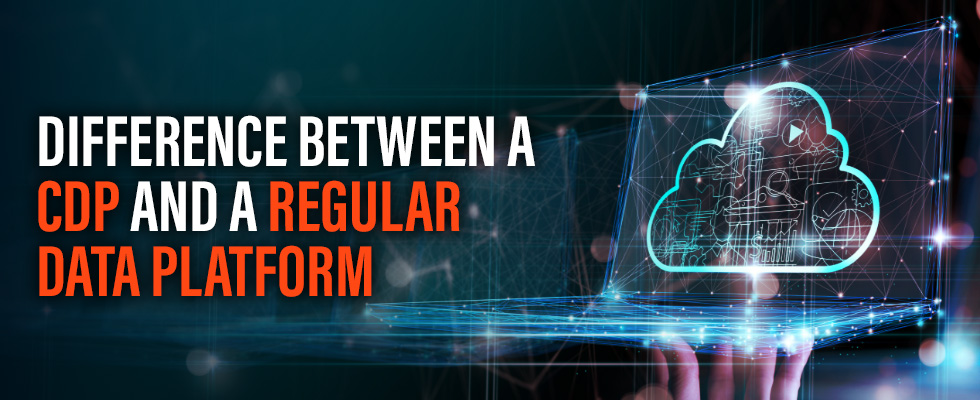While customer data platforms (CDPs) and “regular” data platforms, or data management platforms, might sound similar and might provide organizations with similar benefits, they are not the same. They can, however, be used in conjunction with one another in order to enrich company data and target customers more effectively.
Keep reading to learn more about the differences between CDPs and data platforms, how each works, and some best practices for making the most out of each type of data platform.
Table Of Contents
What’s a CDP?
A CDP is a software solution that unifies first-party customer data collected across several touchpoints and brings it together in one central location.
For example, a customer might interact with a brand on Twitter, through live chat, and over email. That same individual might also buy things online through the brand’s ecommerce site, and they might also spend time looking at products they end up deciding not to buy, at least not yet.
Organizations use CDPs to consolidate all of this information in one central dashboard, giving them a clearer picture of each customer and enabling brands to create robust customer profiles. This data can then be sent to other systems to help brands target customers more precisely and make better business decisions.
What’s a data platform?
A regular data platform is a software solution that collects data from first-, second-, and third-party sources to create customer profiles that tend to be more anonymized than the profiles created by CDPs. Such data includes web and app usage data; data collected from marketing campaigns; and data generated from marketing automation efforts.
Data platforms often incorporate different layers with different functionality to allow organizations to get the most out of all their data. These layers may include such things as event streaming tools such as Kafka and noSQL or in-memory databases.
While the data that resides within a CDP is controlled by a single company, data from a regular data platform is used by demand-side platforms and supply-side platforms to, among many other things, increase advertising effectiveness with better targeting, customization, and personalization.
According to a recent Gartner report, 80% of organizations are either using data platforms or in the process of implementing one. That’s because regular data platforms can deliver a ton of value to organizations thanks to things such as lookalike modeling, which helps companies identify users who behave similarly to existing customers, and user profiling, which groups buckets of users that share similar characteristics together for improved ad targeting.
How does a CDP work?
At a high level, CDPs collect different types of data to create robust, 360-degree customer profiles. The data types are:
1. IDENTITY DATA
Identity data sits at the core of a customer profile. This data is entirely unique and includes such things as a customer’s name, address, demographic information, contact information, work information, social media profiles, and account numbers.
2. DESCRIPTIVE DATA
Companies collect descriptive data to get a deeper understanding of each individual customer. This data includes career information (e.g., previous employers, job titles, and salaries), family information, lifestyle information (e.g., homeowner vs. renter, what kind of car the individual drives, and whether they have any pets), and information about hobbies and other interests.
3. QUANTITATIVE DATA
Quantitative data measures customer behaviors such as how many products they’ve bought, whether they’re returned them, and how often they abandon their shopping carts. Additionally, quantitative data includes email open and clickthrough rates, website visits, social media engagement, and customer service interactions.
4. QUALITATIVE DATA
Last but not least, companies collect qualitative data to figure out the why behind customer actions and behaviors. This data aims to determine what motivates individual consumers to make the decisions they do. Why did someone buy something? How did a customer find out about our brand in the first place? How likely is the customer to recommend our products and services to a peer? The answers to these questions help companies understand what’s working and what needs to be changed.
While CDPs often use first-party data and then enrich customer profiles with second-and third-party data. Ideally, the end result is a 360-degree view of each customer, which makes it easier to target the audience more effectively. Ultimately, brands use CDPs to engage existing customers, increase retention, collect feedback, and identify potential upselling and cross-selling opportunities, among other use cases.
How does a regular data platform work?
A data platform combines various functionalities to enable companies to optimize their state storage, processing, analytics, and business logic. The best data platforms also use some form of AI and/or ML to enhance their data analytics and empower better business decisions.
If you’ve ever received a perfect upsell offer at the perfect time, then you’ve seen a data platform at work. The key difference between CDPs and data platforms is the fact that customer profiles in data platform are created with second-party data (e.g., from a data exchange service) and third-party data (e.g., based on cookies and website impressions) and are therefore anonymous, containing zero personally identifiable information (PII).
Among many other things, data platforms are ideal for marketers who want to build campaigns that target unfamiliar audiences. For example, a B2B tech company that builds project management software might use a data platform from a company like LinkedIn to advertise their solutions to project managers who work at Fortune 1000 companies. This company would have likely found success selling to folks who work at Fortune 1000 organizations in the same capacity and would use a data platform to target individuals who “look like” their ideal customer.
While organizations usually hold onto data in their CDP for as long as they’re legally able to because it contains PII and the resulting profiles are more robust, data platform data is usually more short-term in nature.
CDP Best Practices
Are you getting ready to add a CDP to your martech stack? Here are some best practices to follow to unlock the full value of the technology.
1. GET YOUR TEAM ON BOARD
First things first: If you want to unlock the full value of CDP technology, you need to make sure your team knows exactly why you’re investing in it and the opportunities it creates. Once you have your team on board, it’s time to agree on what it is you hope to accomplish.
For example, you might use a CDP to deliver more personalization to customers. Or, you might want to improve website interactions by understanding more about who you’re talking to. By working collaboratively to figure out these priorities, you can hit the ground running and ensure everyone is aligned from the outset.
2. IDENTIFY YOUR DATA SOURCES
Next, you need to identify the type of data you’re going to collect and the tools you’re going to use to make that happen. For example, this might include social media networks, your company blog, and email marketing.
3. ENSURE COMPLIANCE
Since CDPs collect and store PII, it’s important to ensure you’re complying with all relevant regulations around consumer data. For example, if you’re collecting data on customers in Europe, you need to comply with the General Data Protection Regulation (GDPR). If you’re focusing on customers in California, you’ll need to abide by the California Consumer Privacy Act (CCPA). If you’re operating in Canada, you will need to adhere to the Personal Information Protection and Electronic Documents Act (PIPEDA). You get the gist.
4. LOOK FOR A SOLUTION
After you’ve outlined your goals and use cases and realized what you need to do to ensure compliance, it’s time to start looking for a CDP. As you begin narrowing down your options, it’s important to look for a solution that enables you to ingest, analyze, and act on data in real time. In today’s age of ubiquitous connectivity, organizations need to be able to respond to opportunities with lightning-fast precision, which is why speed is one of the most important characteristics to look for in a CDP.
Data platform: Best practices
Unfortunately, you can’t just decide to add a data platform to your proverbial arsenal and get great results. However, here are some best practices that can enable you to use a data platform to its full potential.
1. DEFINE YOUR CRITERIA
Before you begin using a data platform, you first need to determine your north star. For example, marketers, agencies, and publishers will likely have different goals, as will CIOs or developers. While marketers might be interested in learning more about specific customers, agencies might want to produce more robust reports about who’s interacting with their campaigns. At the same time, publishers might be interested in learning more about their readers so they can deliver more personalized experiences moving forward.
2. SEARCH FOR A SOLUTION
After you’ve figured out what you’re trying to accomplish, it’s time to do your due diligence and search for a solution. You need to look into how data platforms collect and organize data, what the underlying data sources are, and whether the solution integrates with additional platforms. What’s more, you also need to pay attention to the insights a data platform offers. Ultimately, the right platform will enable you to unlock crucial, real-time insights about unknown audiences and will enable you to achieve ROI with little to no maintenance on your end.
3. OPTIMIZE YOUR CAMPAIGNS
Once you have a solution in place, it’s important to never rest on your laurels. Optimize your campaigns over time to continue to get better and better results. Leading data platforms provide tools that you can adjust to improve your outreach over time, maximizing ROI along the way.
CDP vs. Data platform: Which is right for you?
If you’re looking to collect and leverage first-party data to learn more about your customers on an individual level, a CDP is your best bet. If, on the other hand, you want to build advertising campaigns that target new customers using third-party data, you need a regular data platform.
But guess what? There’s no rule that says you can’t use both of them and get the best of both worlds along the way.
Volt Active Data is a data platform that was designed to enable companies to tap into the full potential of their real-time data. Get started with Volt here.



